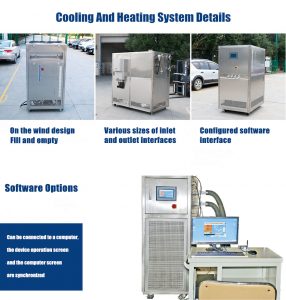Why does a chiller need to be installed for cooling the water storage tank?
The main reasons for configuring a chiller for cooling the water storage tank are related to the following aspects:
Temperature Control: In many industrial and commercial applications, such as air conditioning systems, chemical processes, food processing, pharmaceutical production, etc., the water in the water storage tank needs to be maintained at a specific low temperature state to meet process requirements or provide cooling capacity. The chiller reduces the temperature of water in the storage tank by circulating cooling water or refrigerant, and maintains this temperature within the set range to ensure stable system operation and product quality.
Improving Efficiency: In some applications, such as the comparison between air-cooled water chillers and water-cooled chillers, it is mentioned that chillers can provide higher cooling efficiency by directly cooling circulating water instead of relying on ambient air for heat dissipation. Especially when the ambient temperature is high, the chiller can provide low-temperature water more stably, avoiding the impact of environmental temperature fluctuations on the cooling effect.
Save Water Resources and Energy: The cooling system of the water storage tank equipped with a chiller can reduce water consumption by circulating cooling water. Meanwhile, modern chiller design emphasizes energy efficiency and adopts energy-saving technologies such as variable frequency drive and high-efficiency heat exchangers to reduce energy consumption.
Equipment Protection: In some process flows, such as reactor cooling in pharmaceutical processes and precision equipment cooling in semiconductor manufacturing, the chiller stabilizes the cooling water temperature to prevent equipment damage or performance degradation caused by high temperatures, thereby extending the service life of the equipment.
Environmental Adaptability: In areas with unreliable natural water sources or high temperatures, chillers can provide stable cooling capacity and are not affected by external environmental changes, ensuring uninterrupted cooling services throughout the year.
Flexibility and Scalability: The chiller can adjust its cooling capacity according to actual needs. For systems that require flexible adjustment of cooling capacity or may be expanded in the future, the chiller provides good adaptability and scalability.
In summary, configuring a chiller for cooling water storage tanks not only ensures precise temperature control and improves overall system efficiency, but also plays an important role in protecting critical equipment, saving resources, and adapting to different environmental conditions.
customized indoor and outdoor chillers
関連推奨品
-
The Difference Between Small Air Cooled And Small Water Cooled Chillers At Work
1452The different types of chillers are divided into two types according to the style, appearance, built-in configuration, condenser shape, etc. The heat dissipation of the unit through the finned condenser is called a small air cooled chiller; The he...
詳細を見る -
大型急速冷凍コンプレッサーの冷却問題にどう対処するか?
1387大型急速冷凍機のコンプレッサーには多くの種類があり、機種によってコンプレッサーのメーカーや型式も異なる。コンプレッサーの温度が高くなりすぎると、故障の原因になるため、冷却も重要です。
詳細を見る -
What Are the Commonly Used Refrigerants For Brand Selection of Refrigerating Chillers?
1114When the enterprise chooses the refrigerant in the cryo chillers unit brand, what should it need to pay attention to the present market commonly used refrigerant? What is the difference between specific refrigerant properties? Take a look at the b...
詳細を見る -
Application and function of explosion-proof constant temperature circulation system
975Temperature control in drug research and development and chemical experiments, as well as temperature control in small-scale experimental production and industrial production, all require highly dynamic constant temperature controllers. The chemic...
詳細を見る
 LNEYA工業用冷凍機 メーカー サプライヤー
LNEYA工業用冷凍機 メーカー サプライヤー














